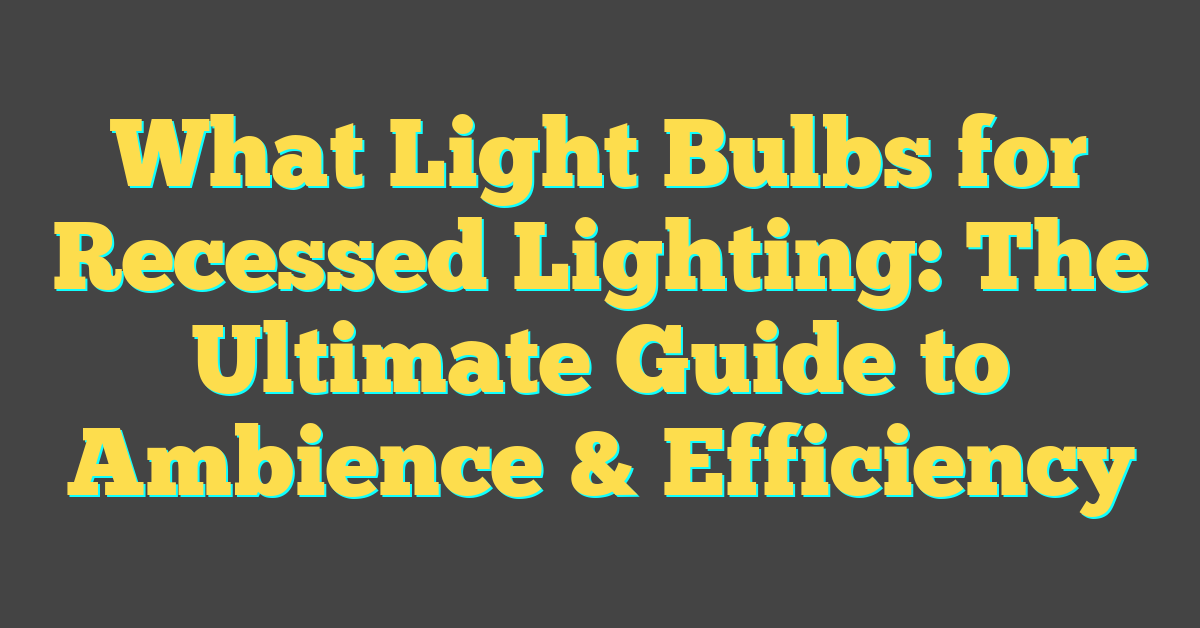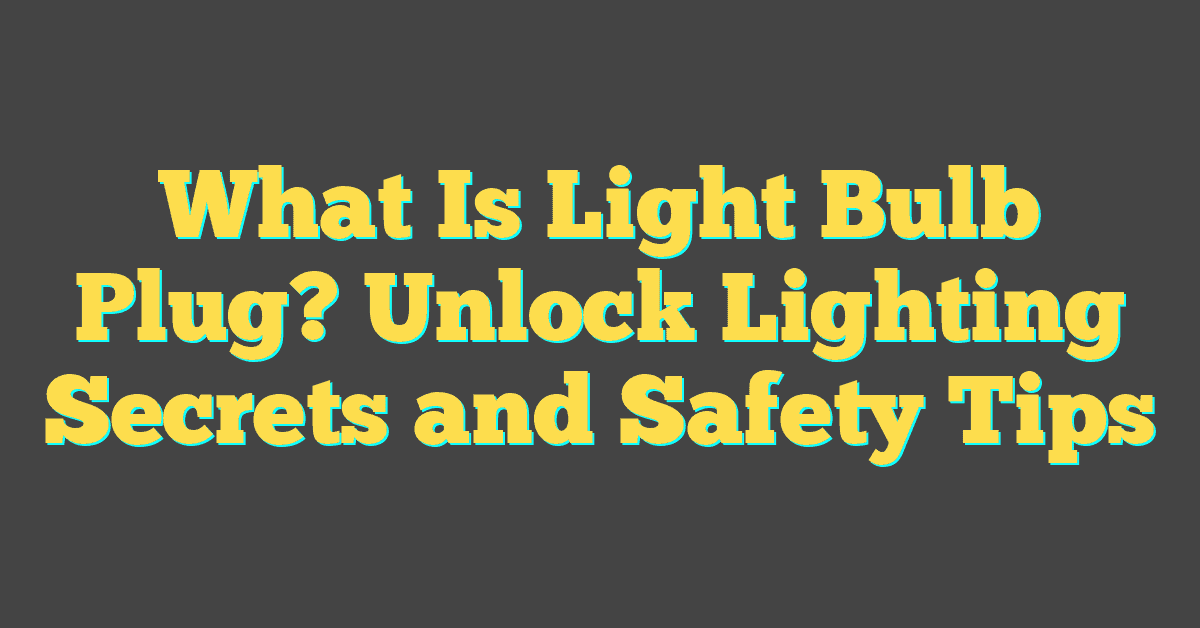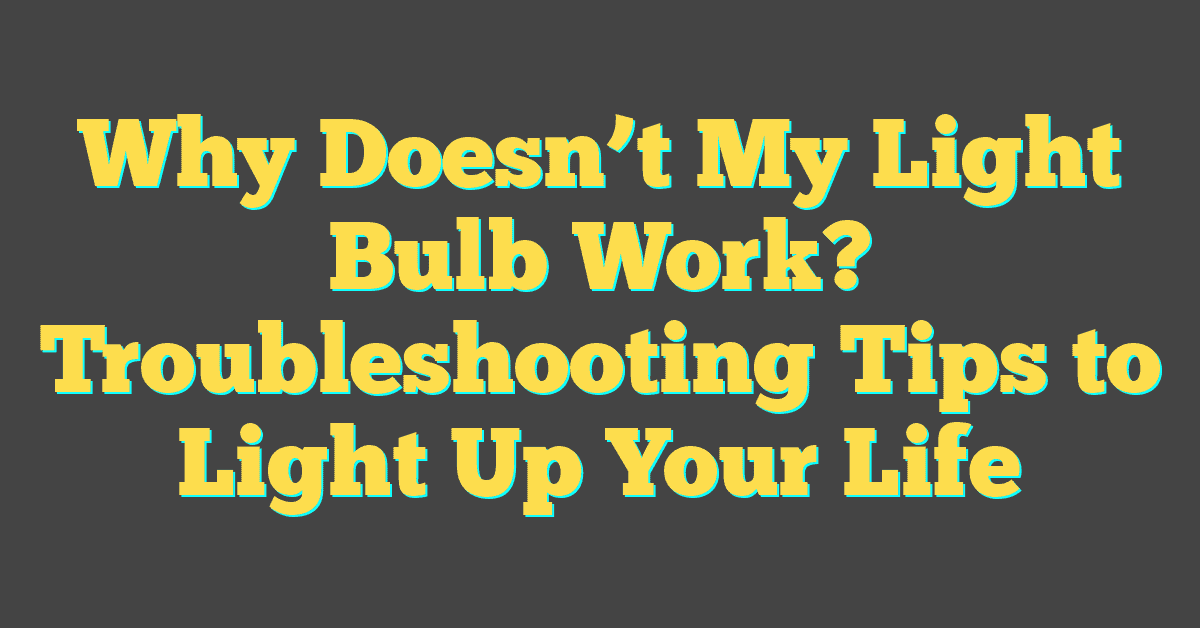Choosing the right light bulbs for your recessed lighting can feel like navigating a labyrinth in the dark. You want that perfect ambiance, a blend of warmth and brightness that transforms a room. But with so many options, where do you even start?

Don’t worry, you’re about to shed some light on the subject. Whether you’re looking for energy efficiency, longevity, or just the right glow, picking the ideal bulb can elevate your space from cozy to magazine-cover worthy.
So buckle up, because you’re on the brink of illumination enlightenment. Let’s dive into the bright world of recessed lighting and find the bulbs that’ll make your home shine.
Types of Light Bulbs for Recessed Lighting
When you’re diving into the world of recessed lighting, you’ll find that bulb type is not just about brightness or energy efficiency; it’s about creating the perfect mood for each space in your home. Let’s break down the various bulb types you can choose from.
Incandescent Bulbs
- Traditional choice
- Warm glow
These are the classic bulbs we grew up with. They’re affordable and give off a warm light that’s perfect for creating a cozy atmosphere in living rooms or bedrooms. But, they’re not the most energy-efficient option out there.
Halogen Bulbs
- Bright, crisp light
- More energy-efficient than incandescents
Halogen bulbs are a step up in the efficiency department. They offer a pristine, white light, which is why they’re a hit for places like kitchens or bathrooms where detail-oriented tasks are performed.
Compact Fluorescent Lamps (CFLs)
- Energy savers
- Wide color range
CFLs have made a name for themselves primarily due to their energy-saving properties. They use about one-third of the energy of incandescent bulbs and last ten times longer. Plus, you’ve got options with the spectrum of colors they come in.
- Top of the line in efficiency
- Long life span
- Versatile
LEDs reign supreme in the realm of energy efficiency and lifespan. While they’re a bit pricier upfront, their longevity and low power consumption will save you money in the long run. These bulbs are incredibly versatile, too, fitting into almost every type of recessed fixture and offering a range of color temperatures.
Now that you’re acquainted with the types of bulbs available, you’ll need to consider factors like color temperature, lumens, and how they’ll look in your recessed fixtures. Remember, the right light can dramatically affect a room’s ambience, so take your time and find the bulb that’s just right for your space. You’re building not just lighting, but the atmosphere of your home—one bulb at a time.
Choosing the Right Bulb for Your Needs

When it comes to recessed lighting, selecting the right bulb isn’t just about brightness; it’s about creating the perfect ambiance for your space. Start by considering the color temperature of a bulb, measured in Kelvin (K). Lower temperatures offer a warm, cozy glow, ideal for living rooms and bedrooms, whereas higher temperatures provide a bright, crisp light, perfect for kitchens and bathrooms.
Here’s what to keep in mind:
- Incandescent bulbs radiate a warm light and have a lower upfront cost but aren’t as energy-efficient as other options.
- Halogen bulbs offer a brighter light and are more energy-efficient than incandescent but do require frequent replacements.
- CFLs provide a wide range of color temperatures and use less power, though they can take a moment to reach full brightness.
- LEDs are the cream of the crop in terms of energy efficiency and longevity, and they are available in a wide range of color temperatures.
As you plan your space, remember that lumens measure light output. More lumens equals more light. To replace a 60-watt incandescent bulb, you’ll want an LED or CFL with about 800 lumens. Check the lumens to ensure you’re getting the level of brightness you’re after without the extra energy costs.
Here’s a quick reference guide:
| Bulb Type | Brightness (Lumens) | Energy Used (Watts) |
|---|---|---|
| Incandescent | 800 | 60 |
| Halogen | 800 | 42-53 |
| CFL | 800 | 13-15 |
| LED | 800 | 8-12 |
Remember, dimmable options can add versatility to your lighting, allowing you to adjust the brightness according to the time of day or desired mood.
« What Light Bulbs Can Be Used Outside? Discover the Best for Your Yard
Why Don’t Light Bulbs Last? Discover the Shocking Reasons Behind Their Short Lifespan »
When tackling a home DIY lighting project, it’s important to think about the long-term. Investing in quality bulbs that meet your specific needs will save you time and money in the long run. Consider how the light will interact with your room’s color scheme and furnishings. The right lighting can turn a standard room into a statement of your personal style.
Understanding Light Bulb Specifications

Diving deeper into the world of light bulbs, you’ll quickly realize that they’re more than just about wattages. Lumens, color temperature, and life expectancy are all critical specifications you need to decipher to ensure you’re selecting the perfect bulb for your recessed lighting setup.
Lumens measure the amount of light a bulb emits. It’s a direct indicator of how bright your bulb will be. The higher the lumens, the brighter the light. For areas like your kitchen or home office, higher lumens are essential for clear visibility, while bedrooms and living rooms can benefit from softer, lower-lumen lighting.
When it comes to color temperature, the measurement in Kelvin (K) tells you how warm or cool the light will appear. A lower Kelvin number means a warmer, more inviting light, usually around 2700K to 3000K, which is ideal for living spaces to create a cozy ambiance. Alternatively, a cooler light with a higher Kelvin value, such as 3500K to 5000K, provides a more energizing environment, fantastic for task lighting or accentuating modern decor.
Another important factor is CRI, or Color Rendering Index, which measures a light bulb’s ability to reveal the true colors of objects compared to natural sunlight. A CRI of 80 to 90 is generally considered good and suitable for most home lighting situations.
Here’s a quick reference table for these key bulb specifications:
| Specification | Ideal Range | Application |
|---|---|---|
| Lumens | 600-1200 | General home use |
| Color Temperature | 2700K-5000K | Ambient to task lighting |
| CRI | 80-90 | Accurate color rendering |
Lastly, consider the bulb’s life expectancy. LEDs are known for their longevity often lasting up to 50,000 hours, which far exceeds that of incandescent and halogen bulbs. This long lifespan combined with the energy efficiency makes LEDs a savvy investment for the long term.
Energy Efficiency and Cost Considerations

When you’re in the throes of selecting bulbs for your recessed lighting, it’s crucial to weigh the energy efficiency and cost implications of your choices. Energy-efficient bulbs may have a higher upfront price, but they often lead to hefty savings on your electric bill over time. Let’s break it down.
LED bulbs are the reigning champions in the realm of energy efficiency. They use about 75% less energy and last 25 times longer than incandescent bulbs, making them the go-to choice for cost-conscious homeowners. While the initial investment is higher for LEDs, the return on that investment is quickly realized through decreased energy bills and fewer replacements.
To put that into perspective, here’s a quick comparison:
| Bulb Type | Expected Lifespan | Energy Used |
|---|---|---|
| LED | 25,000 hours | 10 watts |
| Incandescent | 1,000 hours | 60 watts |
| Compact Fluorescent | 8,000 hours | 14 watts |
Circling back to lumens, remember that a higher lumen output doesn’t necessarily mean higher energy consumption. This is especially poignant with LED technology, where you get more brightness for less power. You’ll also discover that LEDs come with dimmer compatibility, reducing energy usage further when you dim the lights for ambiance or to suit the time of day.
Another critical factor is the Color Rendering Index (CRI). Higher CRI bulbs usually don’t consume more energy; instead, they simply make colors pop more vividly under the light. So, if you’re highlighting artwork or want to ensure natural-looking hues, you might prioritize high-CRI options without affecting your energy overhead.
Switching to energy-efficient lighting isn’t just good for your wallet; it’s a nod to environmental stewardship. By opting for LEDs, you’re cutting down on waste and reducing the demand for power. It’s about finding the balance between aesthetics, functionality, and sustainability while remembering that the best choice respects both your immediate needs and long-term returns.
Tips for Creating the Perfect Ambience

Creating the right ambience is not just about selecting a bulb with the correct lumens or color temperature; it’s about understanding how lighting affects mood and complements your space. Here are some tips that’ll help you illuminate your home like a pro:
Understand Layered Lighting
Layering light is essential for both functionality and atmosphere. Consider a mix of ambient, task, and accent lighting in your space:
- Ambient lighting provides the overall illumination of a room.
- Task lighting focuses light on specific areas for reading, cooking, or working.
- Accent lighting highlights architectural features or artwork.
Utilizing different layers enables you to control the vibe and functionality of your lighting setup.
Adjust Light for the Time of Day
To synchronize your home’s lighting with natural body rhythms, use brighter, cooler lights during the day, which can enhance concentration and alertness. As evening approaches, shift to warmer tones to promote relaxation. This not only creates ambiance but can also support your natural circadian rhythms.
Dimmers Are Your Best Friend
Installing dimmers on your recessed lights offers flexibility in adjusting light levels. With dimmers, you can:
- Transform a brightly lit kitchen into a cozy dining space.
- Lower lights for a movie night without making the room pitch black.
- Create a soft glow for intimate gatherings or relaxation.
Consider Smart Bulbs for Greater Control
Smart bulbs can be a game-changer for achieving the perfect ambience. Features to look for:
- Color changing capabilities to match any mood or occasion.
- Scheduling options to automate lighting based on time or events.
- Remote control through apps, adding convenience and accessibility.
Mix and Match Bulbs
Don’t be afraid to use different types of bulbs within the same room. Combining various color temperatures and bulb styles can add depth and character to your space. Experiment with:
- Warmer bulbs for cozy nooks or reading corners.
- Cooler, brighter bulbs where detailed tasks are performed.
By employing these strategies, you’ll be able to craft an inviting atmosphere that’s both pleasant and practical. Remember, lighting should adapt to your needs, not the other way around. Play around with different configurations and enjoy the process of creating a home that feels just right.
Conclusion
You’ve got the scoop on making your recessed lighting shine. Remember, it’s all about balance—finding that sweet spot where lumens, color temperature, and CRI meet your space’s needs. Embrace energy-efficient LEDs to save on bills and keep an eye on longevity. Whether you’re setting the mood or illuminating a task, dimmers and smart bulbs put the power at your fingertips. Mix it up to keep your home feeling cozy yet functional. Now, you’re ready to light up your world with confidence and a touch of eco-consciousness. Go ahead, flip the switch and watch your space transform!
Frequently Asked Questions
What factors should I consider when choosing a bulb for recessed lighting?
The primary factors to consider include lumens (brightness), color temperature, and CRI (Color Rendering Index) for color accuracy. Energy efficiency and bulb lifespan are also important considerations, impacting ongoing costs and replacement frequency.
How do lumens, color temperature, and CRI affect my lighting choices?
Lumens measure brightness – the higher the lumens, the brighter the light. Color temperature dictates the color of the light (warm to cool), while CRI indicates how true to color the light source is. Matching these factors to room function and personal preference is key.
Why are LED bulbs recommended for recessed lighting?
LED bulbs are recommended due to their superior energy efficiency, which translates into energy savings, and their long lifespan compared to traditional bulbs, reducing the need for frequent replacements.
Can lighting create different ambiances in a room?
Yes, you can create different ambiances through layered lighting, adjusting light for time of day, using dimmers, and choosing smart bulbs for flexibility. The right mix and match of bulbs can create an inviting and functional atmosphere.
What is the significance of finding a balance in lighting choices?
Balance is vital for aesthetics, functionality, and sustainability. It involves choosing lighting that complements the room’s design, provides practical illumination, and is energy-efficient to minimize environmental impact.




